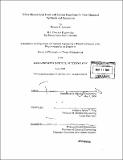| dc.contributor.advisor | Jackie Y. Ying. | en_US |
| dc.contributor.author | Lancaster, Thomas M. (Thomas Michael), 1977- | en_US |
| dc.contributor.other | Massachusetts Institute of Technology. Dept. of Chemical Engineering. | en_US |
| dc.date.accessioned | 2005-10-14T20:09:24Z | |
| dc.date.available | 2005-10-14T20:09:24Z | |
| dc.date.copyright | 2004 | en_US |
| dc.date.issued | 2004 | en_US |
| dc.identifier.uri | http://hdl.handle.net/1721.1/29373 | |
| dc.description | Thesis (Ph. D.)--Massachusetts Institute of Technology, Dept. of Chemical Engineering, 2004. | en_US |
| dc.description | Includes bibliographical references. | en_US |
| dc.description.abstract | In chromatography, the selective separation for large molecules, polymers, and proteins is of particular interest. To achieve quality separations, the stationary phase should exhibit pore diameters greater than 10 nm to facilitate the diffusion of large analytes throughout the stationary phase. In packed-bed applications, narrow particle and pore size distributions and uniform particle shape would lead to improved separations. Thus, spherical stationary phase particles are often preferred, but the challenge has been to combine spherical particle morphologies, high surface areas, large mesopores, and narrow pore size distributions. We have successfully created a new three-step synthesis of spherical MCF (S- MCF) particles utilizing sodium fluoride as a condensation catalyst. The approach allowed for independent control over S-MCF particle and pore size, and was extended to other non-ordered porous silicas. The S-MCF particles were engineered into a reverse- phase chromatographic column and achieved good separation ability for a mixture of aryl ketones. By relating chromatographic performance to S-MCF surface silanol chemistry, an improved S-MCF chromatographic support was realized, which rivaled the separation capability of a commercially available chromatographic support. The asymmetric Diels-Alder (ADA) reaction is very useful in building complex chiral molecules through the formation of chiral carbon ring structures, and it presents an excellent route for generating new therapeutic molecules. Although these compounds are of great importance, homogeneous ADA catalysts exhibit moderate activities and are not readily recovered and reused. This has prevented the ADA reaction from being widely practiced in the pharmaceutical industry. | en_US |
| dc.description.abstract | (cont.) To create more attractive catalysts, MCF was used to anchor chiral bisoxazoline-copper(II) complexes for the ADA reaction. We have examined the effect of catalyst environment on activity and selectivity through the use of different catalyst ligands, linker groups, and silanol capping agents. The MCF-immobilized catalysts showed enhanced activity compared to their homogeneous counterparts, and the phenomenon was correlated to bisoxazoline ligand loading on the MCF surface. Batch recycling experiments and continuous ADA reactor trials showed that the MCF-anchored catalysts were reusable and stable. Catalytic performance was measured through in situ infrared spectroscopy, and a Michaelis-Menten kinetic model with product inhibition was applied to determine relevant kinetic parameters for the best heterogenized catalyst. The Heck reaction is a powerful synthetic tool in organic chemistry for C-C bond formation through a liquid-phase reaction between aryl halides and alkenes. It has great industrial potential, but the Heck coupling reaction catalysts have traditionally suffered from low oxygen tolerance and poor reusability due to palladium cluster growth, agglomeration and oxidation. In this work, a new mesoporous and crystalline carbon, carbon nanofoam (CNF), was examined as a Pd cluster support for the coupling of 4-bromoacetophenone and n- butyl acrylate. Using CNF as a support, we successfully synthesized Pd/CNF catalysts using a vapor grafting approach and demonstrated high activities for the Heck coupling at 140⁰C. The Pd/CNF catalysts showed remarkable performance enhancements compared to Pd/activated ... | en_US |
| dc.description.statementofresponsibility | by Thomas M. Lancaster. | en_US |
| dc.format.extent | 103 leaves | en_US |
| dc.format.extent | 4657248 bytes | |
| dc.format.extent | 4657056 bytes | |
| dc.format.mimetype | application/pdf | |
| dc.format.mimetype | application/pdf | |
| dc.language.iso | eng | en_US |
| dc.publisher | Massachusetts Institute of Technology | en_US |
| dc.rights | M.I.T. theses are protected by copyright. They may be viewed from this source for any purpose, but reproduction or distribution in any format is prohibited without written permission. See provided URL for inquiries about permission. | en_US |
| dc.rights.uri | http://dspace.mit.edu/handle/1721.1/7582 | |
| dc.subject | Chemical Engineering. | en_US |
| dc.title | Silica mesocellular foam and carbon nanofoam for fine chemical synthesis and separation | en_US |
| dc.type | Thesis | en_US |
| dc.description.degree | Ph.D. | en_US |
| dc.contributor.department | Massachusetts Institute of Technology. Department of Chemical Engineering | |
| dc.identifier.oclc | 56052301 | en_US |
